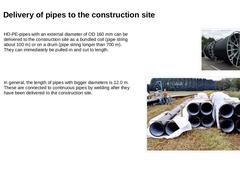
|

|
HD-PE-pipes with an external diameter of OD 160 mm can be delivered to the construction site as a bundled coil (pipe string about 100 m) or on a drum (pipe string longer than 700 m). They can immediately be pulled-in and cut to length. | (Image: HD-PE-pipe on a as coil reel)
| |
In general, the length of pipes with bigger diameters is 12.0 m. These are connected to continuous pipes by welding after they have been delivered to the construction site. | (… |
|
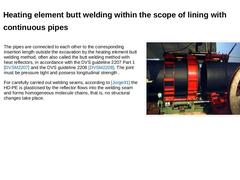
|

| (Image: Conventional sliplining process with annular space [FI-Teerb] - Welding of HD-PE pipes outside the excavation with the heating element butt-welding process)
The pipes are connected to each other to the corresponding insertion length outside the excavation by the heating element butt welding method, often also called the butt welding method with heat reflectors, in accordance with the DVS guideline 2207 Part 1 [DVSM2207] and the DVS guideline … |
|
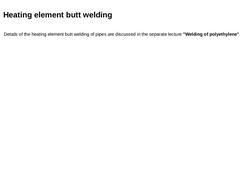
|

|
Details of the heating element butt welding of pipes are discussed in the separate lecture "Welding of polyethylene". |
|
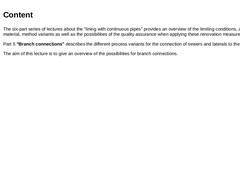
|

The six-part series of lectures about the "lining with continuous pipes" provides an overview of the limiting conditions, applied material, method variants as well as the possibilities of the quality assurance when applying these renovation measures. Part 5 "Branch connections" describes the different process variants for the connection of sewers and laterals to the liner. The aim of this lecture is to give an overview of the possibilities for branch … |
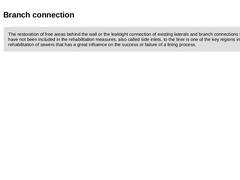
|

|
The restoration of free areas behind the wall or the leaktight connection of existing laterals and branch connections that have not been included in the rehabilitation measures, also called side inlets, to the liner is one of the key regions in the rehabilitation of sewers that has a great influence on the success or failure of a lining process. |
|
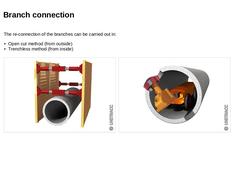
|

|
The re-connection of the branches can be carried out in: - Open cut method (from outside)
- Trenchless method (from inside)
| |
(Image: Open cut method)
|
(Image: Repair)
|
|
|

|

|
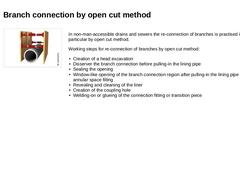
|

| (Image: Open cut method)
|
In non-man-accessible drains and sewers the re-connection of branches is practised in particular by open cut method. Working steps for re-connection of branches by open cut method: - Creation of a head excavation
- Disserver the branch connection before pulling-in the lining pipe
- Sealing the opening
- Window-like opening of the branch connection region after pulling-in the lining pipe and annular space filling
- Revealing and cleaning …
|
|
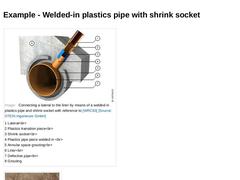
|

| (Image: Connecting a lateral to the liner by means of a welded-in plastics pipe and shrink socket with reference to [WRC83] [Image: S&P GmbH])
| | (Image: Welded-on PE-nozzle [Jürge05])
|
|
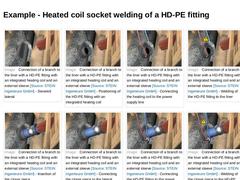
|

|
(Image: Connection of a branch to the liner with a HD-PE fitting with an integrated heating coil and an external sleeve - Severed lateral)
|
(Image: Connection of a branch to the liner with a HD-PE fitting with an integrated heating coil and an external sleeve - Positioning of the HD-PE fitting with an integrated heating coil)
|
(Image: Connection of a branch to the liner with a HD-PE fitting with an integrated heating coil and an external sleeve - … |
|
|
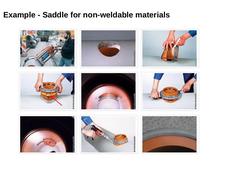
|

|
(Image: Fabekun® saddle with ball joint - core drilling [FI-Funke])
|
(Image: Fabekun® saddle with ball joint - installation position [FI-Funke])
|
(Image: Fabekun® saddle with ball joint - application of the lubricant [FI-Funke])
|
|
(Image: Fabekun® saddle with ball joint - installation [FI-Funke])
|
(Image: Fabekun® saddle with ball joint - installation [FI-Funke])
|
(Image: Fabekun® saddle with ball joint - tightening the grey threaded ring [FI-… |
|
|

|

|
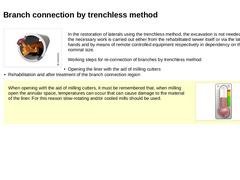
|

| (Image: Repair)
In the restoration of laterals using the trenchless method, the excavation is not needed as all the necessary work is carried out either from the rehabilitated sewer itself or via the lateral by hands and by means of remote controlled equipment respectively in dependency on the nominal size. Working steps for re-connection of branches by trenchless method: - Opening the liner with the aid of milling cutters
- Rehabilitation and after treatment …
|
|
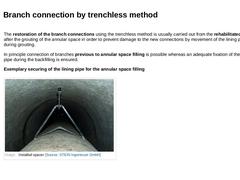
|

|
The restoration of the branch connections using the trenchless method is usually carried out from the rehabilitated sewer after the grouting of the annular space in order to prevent damage to the new connections by movement of the lining pipes during grouting. In principle connection of branches previous to annular space filling is possible whereas an adequate fixation of the lining pipe during the backfilling is ensured. Exemplary securing of the … |
|
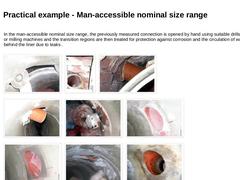
|

|
In the man-accessible nominal size range, the previously measured connection is opened by hand using suitable drills, cutting or milling machines and the transition regions are then treated for protection against corrosion and the circulation of water behind the liner due to leaks . | |
(Image: Milling open of the GRP pipe to connect a lateral)
|
(Image: Window milled open with lateral)
|
(Image: Pushing the PVC-KG pipe into the lateral that is to be … |
|
|
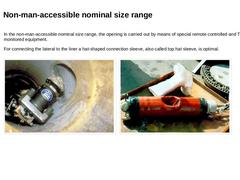
|

|
In the non-man-accessible nominal size range, the opening is carried out by means of special remote controlled and TV monitored equipment. For connecting the lateral to the liner a hat-shaped connection sleeve, also called top hat sleeve, is optimal. | |
(Image: Recreation of the branch connection [FI-Insit] - Opening the connection region of the lateral)
|
(Image: Recreation of the branch connection [FI-Insit] - Packer and top hat sleeve)
|
|
|
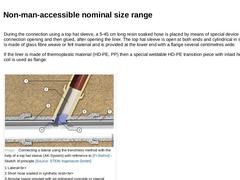
|

| During the connection using a top hat sleeve, a 5-45 cm long resin soaked hose is placed by means of special device in the connection opening and then glued, after opening the liner. The top hat sleeve is open at both ends and cylindrical in shape. It is made of glass fibre weave or felt material and is provided at the lower end with a flange several centimetres wide. If the liner is made of thermoplastic material (HD-PE, PP) then a special weldable … |
|
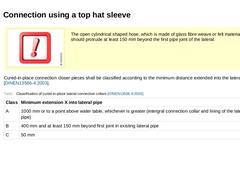
|

| (Image: Attention!)
The open cylindrical shaped hose, which is made of glass fibre weave or felt material, should protrude at least 150 mm beyond the first pipe joint of the lateral. | |
Cured-in-place connection closer pieces shall be classified according to the minimum distance extended into the lateral pipe [DINEN13566-4:2003]. | (Table: Classification of cured-in-place lateral connection collars [DINEN13566-4a]) |
|
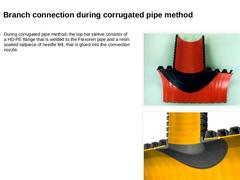
|

|
During corrugated pipe method, the top hat sleeve consists of a HD-PE flange that is welded to the Flexoren pipe and a resin soaked tailpiece of needle felt, that is glued into the connection nozzle. | |
(Image: Corrugated pipe method: Section through the branch connection region with simultaneous rehabilitation of the sewer and laterals [FI-Upono])
|
|
(Image: Corrugated pipe method: Section through the renewed branch connection region with simultaneous … |
|
|
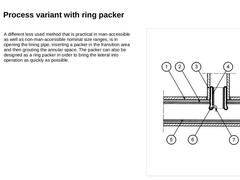
|

|
A different less used method that is practical in man-accessible as well as non-man-accessible nominal size ranges, is in opening the lining pipe, inserting a packer in the transition area and then grouting the annular space. The packer can also be designed as a ring packer in order to bring the lateral into operation as quickly as possible. | (Image: Sealing the annular space in the connecting region of a lateral with a ring or hollow packer [WRC83])
|
|
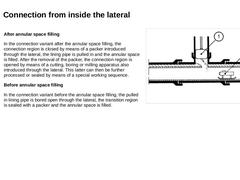
|

| (Image: Creating the branch connection using the trenchless method from the lateral towards the annular space grouting [Gale82] - Working step 2)
After annular space filling In the connection variant after the annular space filling, the connection region is closed by means of a packer introduced through the lateral, the lining pipe is pulled in and the annular space is filled. After the removal of the packer, the connection region is opened by means … |
|
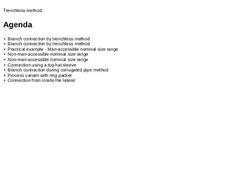
|

|
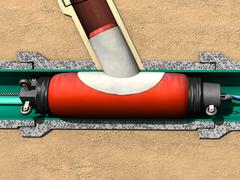
|

This module deals with the branch connection during lining with continuous pipe. |
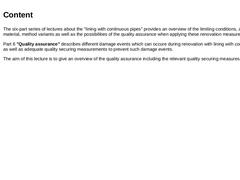
|

The six-part series of lectures about the "lining with continuous pipes" provides an overview of the limiting conditions, applied material, method variants as well as the possibilities of the quality assurance when applying these renovation measures. Part 6 "Quality assurance" describes different damage events which can occure during renovation with lining with continuous pipes as well as adequate quality securing measurements to prevent such damage … |
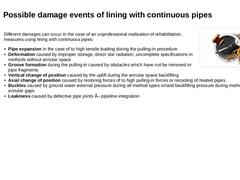
|

| (Image: Damages)
Different damages can occur in the case of an unprofessional realisation of rehabilitation measures using lining with continuous pipes: - Pipe expansion in the case of to high tensile loading during the pulling-in procedure
- Deformation caused by improper storage, direct slar radiation, uncomplete specifications in methods without annular space
- Groove formation during the pulling-in caused by obstacles which have not be removed or pipe …
|
|